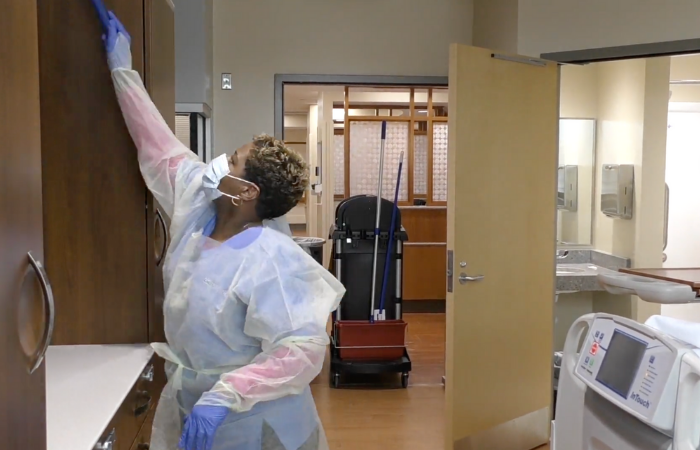
UAB Medicine has always followed strict guidelines for cleaning our hospitals and clinics, and we are doing even more during the COVID-19 outbreak.
To help prevent the spread of the virus, our Environmental Services staff use special cleaning products and procedures and wear personal protective equipment (PPE) such as masks, gloves, face shields or goggles, and gowns. They clean and sanitize more often than usual and in more places, paying special attention to “high-touch” surfaces such as handrails, door handles, elevator buttons, and restrooms.
The Environmental Services (EVS) team is responsible for cleaning most areas across UAB Medicine inpatient areas, including operating rooms, emergency departments, labs, pharmacies, common areas, waiting rooms, stairwells, hallways, and much more.
How does the cleaning process work, and is it different for rooms that were occupied by patients with COVID-19? Are the cleaning products different from what most people have in their homes? Below, we take a closer look at how UAB Medicine is keeping patients, visitors, and staff safe from infection.
Standard Cleaning
The EVS staff perform 700-800 daily room cleanings per day and as many as 12,000 post-discharge “terminal cleanings” per month. A standard terminal clean after a patient is discharged or moved to another area takes 35-40 minutes. Disinfecting and cleaning wipes are used throughout the room, including the bed, countertops, eating tray, light switches, TV controls, bathrooms, and medical equipment. The floors are swept, mopped, and disinfected, and the bed linens are changed.
Enhanced Cleaning
For rooms that were occupied by a patient with COVID-19, EVS team members must wait an hour after the patient has left before starting to clean. They wear full personal protective equipment and follow “enhanced contact precautions”, which call for a double cleaning that takes up to 65 minutes using a disinfectant called Oxivir Tb. A double cleaning includes a normal full cleaning, followed by a second full cleaning and more attention to frequently touched surfaces. Privacy curtains are changed, the walls are cleaned, and the room is sprayed with a hydrogen peroxide-based disinfectant mist that clings to surfaces.
Cleaning Products
The cleaning and disinfecting products used by the EVS team meet strict federal infection-prevention requirements and are approved/registered by the Environmental Protection Agency. They are mixed carefully according to the manufacturer’s instructions through a solution dispenser, and most are not readily available to the general public.
Infection-Control Training
The enhanced cleaning precautions for COVID-19 are not new. They were already in place and were practiced during the Ebola virus outbreak in 2014, and the EVS department regularly conducts training and simulations in following the hospital’s cleaning procedures. As part of its training and quality control, the EVS team uses a product called Glo Germ, which glows under ultraviolet light and helps the staff better understand how germs spread and how to ensure that all surfaces and crevices are thoroughly cleaned. The cleaning process for COVID-19 rooms is similar to what is used for rooms that were occupied by patients who have clostridium difficile (C. diff), a bacterial infection that is difficult to kill and spreads easily. During that second clean, the high-touch surfaces are disinfected with bleach wipes.
“The COVID-19 virus didn’t catch us off guard,” says EVS Senior Director Ed Crump. “We’ve trained for these types of infections, so we were ready for it. Patients who come to UAB Medicine hospitals and clinics can rest assured that we are taking every step possible to make sure all rooms and common areas are safe and sanitized.”
